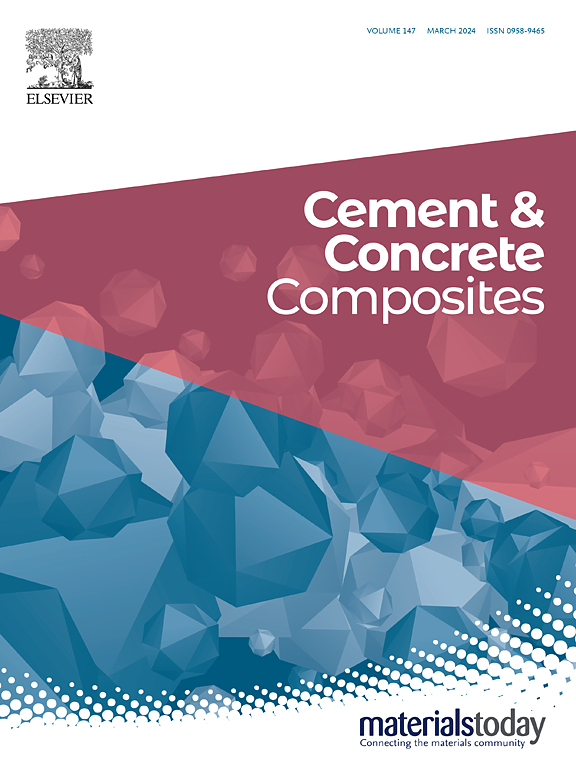Cement-based mechanical metamaterials with spiral resonators for vibration control
IF 10.8
1区 工程技术
Q1 CONSTRUCTION & BUILDING TECHNOLOGY
引用次数: 0
Abstract
This paper presents a single-phase cement-based mechanical metamaterial for vibration control. The unit cell consists of a cement-based matrix with tailored spiral slits, functioning as an embedded spring-mass system. The local resonance of the spiral resonators generates a band gap within a specific frequency range, in which input vibration energy is effectively absorbed. Both experimental and analytical investigations were conducted to demonstrate the feasibility of this cement-based metamaterial. First, the frequency response under sinusoidal excitation was evaluated using finite element analysis. The simulation results indicated that a metamaterial plate consisting of three unit cells exhibits a distinct band gap ranging from 46 Hz to 62 Hz. To validate this unique behavior, specimens were prepared using fiber reinforced cement mortar, and their transmissibility was measured by sine sweep testing. The experimental results confirmed a band gap ranging from 21 Hz to 50 Hz. Furthermore, significant anti-resonant vibration in the spiral resonators was observed during testing. Following this feasibility study, strategies for adjusting the band gap range by tailoring the internal structure were explored. Analytical modeling and numerical simulations suggest that tailoring the unit cell design alone involves a trade-off between achieving a low-frequency band gap and widening the band gap width. However, by employing different unit cell designs and optimizing their arrangement within the structure, it is possible to widen the band gap while maintaining its position. Such non-periodic metamaterial designs offer greater flexibility for tuning band gaps, enabling more versatile applications.
具有螺旋谐振器的水泥基机械超材料的振动控制
本文提出了一种用于振动控制的单相水泥基机械超材料。单元格由水泥基基质组成,具有定制的螺旋缝,可作为嵌入式弹簧质量系统。螺旋谐振器的局部共振在特定频率范围内产生带隙,输入的振动能量在带隙内被有效吸收。实验和分析研究都证明了这种水泥基超材料的可行性。首先,利用有限元方法对正弦激励下的频率响应进行了分析。仿真结果表明,由3个晶胞组成的超材料板在46 ~ 62 Hz范围内具有明显的带隙。为了验证这种独特的行为,用纤维增强水泥砂浆制备了试样,并通过正弦扫描测试测量了它们的透射率。实验结果证实,带隙范围为21 ~ 50 Hz。此外,在测试过程中,还观察到螺旋谐振腔中存在明显的抗谐振振动。在此可行性研究的基础上,探讨了通过调整内部结构来调整带隙范围的策略。分析模型和数值模拟表明,单独定制单极设计涉及到实现低频带隙和扩大带隙宽度之间的权衡。然而,通过采用不同的单晶设计并优化其在结构中的排列,可以在保持其位置的同时扩大带隙。这种非周期性的超材料设计为调整带隙提供了更大的灵活性,从而实现了更多功能的应用。
本文章由计算机程序翻译,如有差异,请以英文原文为准。
求助全文
约1分钟内获得全文
求助全文
来源期刊

Cement & concrete composites
工程技术-材料科学:复合
CiteScore
18.70
自引率
11.40%
发文量
459
审稿时长
65 days
期刊介绍:
Cement & concrete composites focuses on advancements in cement-concrete composite technology and the production, use, and performance of cement-based construction materials. It covers a wide range of materials, including fiber-reinforced composites, polymer composites, ferrocement, and those incorporating special aggregates or waste materials. Major themes include microstructure, material properties, testing, durability, mechanics, modeling, design, fabrication, and practical applications. The journal welcomes papers on structural behavior, field studies, repair and maintenance, serviceability, and sustainability. It aims to enhance understanding, provide a platform for unconventional materials, promote low-cost energy-saving materials, and bridge the gap between materials science, engineering, and construction. Special issues on emerging topics are also published to encourage collaboration between materials scientists, engineers, designers, and fabricators.
 求助内容:
求助内容: 应助结果提醒方式:
应助结果提醒方式:


